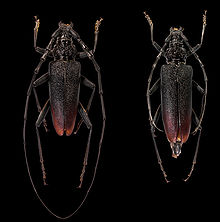| Cerambyx cerdo | |
|---|---|

| |
| Male (left) and Female (right) | |
| Scientific classification | |
| Domain: | Eukaryota |
| Kingdom: | Animalia |
| Phylum: | Arthropoda |
| Class: | Insecta |
| Order: | Coleoptera |
| Family: | Cerambycidae |
| Genus: | Cerambyx |
| Species: | C. cerdo
|
| Binomial name | |
| Cerambyx cerdo | |

| |
| European distribution of C. cerdo | |
| Synonyms | |
| |
Cerambyx cerdo, commonly known as the great capricorn beetle or cerambyx longicorn, is a species of beetle in family Cerambycidae. It occurs in North Africa (Algeria, Morocco, and Tunisia), Europe (Austria, Belarus, Bulgaria, Croatia, the Czech Republic, North Macedonia, France, Georgia, Germany, Hungary, Italy, Moldova, Poland, Portugal, Romania, Serbia, Slovakia, Spain, Sweden, Switzerland, and Ukraine), and Asia (Armenia, Azerbaijan, Georgia, Iran, and Turkey).[1]
The beetle was previously present in the United Kingdom but went locally extinct at least hundreds of years ago. Preserved specimens have been found in the UK, having been dated to around 4000 years old.[2][3]
- ^ a b World Conservation Monitoring Centre (1996). "Cerambyx cerdo". IUCN Red List of Threatened Species. 1996: e.T4166A10503380. doi:10.2305/IUCN.UK.1996.RLTS.T4166A10503380.en. Retrieved 15 November 2021.
- ^ Osterloff, Emily. "Out of the woodwork: the great capricorn beetle". nhm.ac.uk. Natural History Museum. Retrieved 28 January 2021.
- ^ Amos, Jonathan (28 January 2021). "Bog beetles finally reveal their remarkable age". bbc.co.uk. BBC News. Retrieved 28 January 2021.
